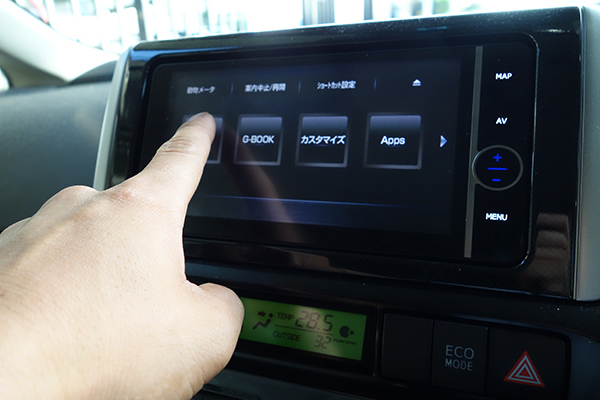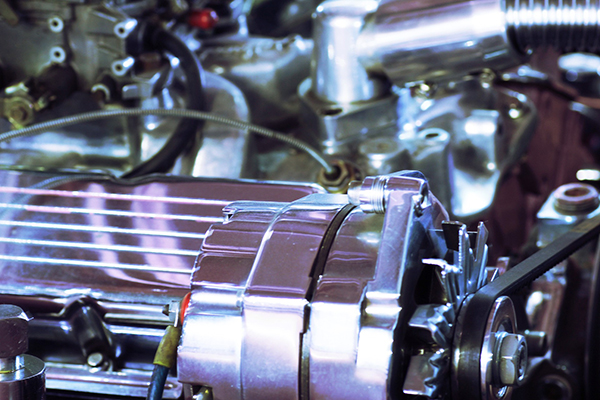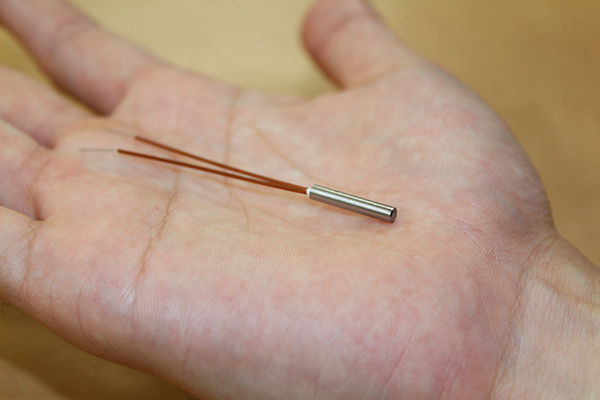Case Studies
-
Onboard (Air Conditioners for Electric Vehicles)
-
category :
Automotive
 Heating equipment used in automobiles has undergone some major changes, amidst a shift in the market away from conventional gasoline-powered vehicles and towards electric vehicles. Electric heaters are now being used to warm the coolant (LLC) that was previously heated using waste heat from the engine.
Heating equipment used in automobiles has undergone some major changes, amidst a shift in the market away from conventional gasoline-powered vehicles and towards electric vehicles. Electric heaters are now being used to warm the coolant (LLC) that was previously heated using waste heat from the engine.
Broadly speaking, automobile manufacturers who select electric heaters for use in their cars have three main requirements:
- Stable heat must continue to be supplied, even in frigid weather
- Considering their use as a heat source to support human life, heaters must be designed and manufactured with safety, comfort, and stability in mind
- The heaters must be produced in a quantity that matches the pace of vehicles manufactured
In order to provide stable heat even in frigid regions, we selected an electric heater that could be used in temperatures of 50ºF (-10ºC) or below, and established a strong production line that would not stop the customer's manufacturing process, no matter what happened.
The customer remains satisfied with Kawai Corporation's production organization and control system, after they paid us many factory visits, conducted inspections of our factory, and held dozens of meetings with us. To provide a stable product supply, the issues of stable product creation, organization for mass production, and design philosophy come into question... but we've earned the customer's satisfaction in all of these areas.
All of our members of Kawai Corporation are proud to be a part of the automotive industry's shift to electric vehicles, and to have been exposed to the stringent control specifications of the industry, which have shaped us and helped us to strengthen our internal management organization even further.
We'd like to extend ourselves into the production of components for the transport industry in the years ahead.Products :
-
Car Washes (Defrosters)
-
category :
Automotive
Automatic car washing machines enclose a car that is stopped, moving along a guide rail to spray the car with water and soap, scrub it, and wipe it... after which the car is sparkling clean once it goes outside the car wash. These car washes are usually located outdoors.
So, what happens with these car washes in cold-weather climates? Any water that gets on the guide rails naturally freezes up, and the car wash cannot move normally. Employees at car washes need to remove the frozen water several times a day. However, these car washes are often visited in such climates, since cars tend to get dirty with snow.
Heaters are used to keep the car washes functioning normally and to reduce this kind of burden on car wash employees. The guide rails are warmed up, so that any water droplets that get on them do not freeze.
Since these heaters are placed inside the guide rails, they need to be waterproof due to cleaning fluid that may drip on them. Because of the way that car washes are designed, these heaters cannot be attached directly onto the rails, which means that they provide indirect heating.
We used a defrosting-type tubular heater in order to achieve the heating power required for indirect heating. In this case, we used a TD (one-sided terminal type) to make it easier to connect to the power supply.
With regular tubular heaters, there are lead wires coming from both ends to connect to the power supply, and the lead wires won't come out in the same direction without bending them an odd number of times. It's naturally more advantageous if the lead wires come out in the same direction; but in order to do this, there must be enough space to accommodate the bending radius, which means a wider installation space. The tubular heater is a great choice for heating large spaces, but it wasn't suited for this situation where only a narrow area needed to be heated. Our TD-type tubular heater solves these problems.
Considering that our customer later asked us for a similar heater to warm not only the guide rails of the car wash but also the brush, it's clear that they were satisfied with the results that Kawai Corporation's heaters can offer.Products :
-
Manufacturing Line (Fuel Tank Molding)
-
category :
Automotive
In the world of manufacturing, creating more compact and lighter products is a topic that many companies are tackling. In particular, each company is intensively applying their know-how to provide lighter automotive parts, which has a major influence on fuel economy.
Conventional fuel tanks are made of steel, but we received an inquiry from an automotive parts manufacturer that wanted to switch to plastic for better fuel economy. This case required a cartridge heater in order to melt the edges of two halves of a bowl-shaped plastic tank, and then to complete the tank by fusing the two halves together at the instance that the edges were melted. If this manufacturing method was successful, a tank of the same size could be produced at less the half the weight.
However, the usage conditions were brutal. With a mold temperature of at least 1100ºF (600ºC) and the heater temperature predicted at around 1300-1500ºF (700-800ºC), and with several points where the heat would accumulate, the heater only lasted for 100 hours on the first try. Having to change the heater on the manufacturing line at this rate every time it burned out would have a negative impact on work efficiency.
The issue at hand was how to provide a long-life heater for this request. Kawai Corporation was eventually able to extend the life of the heater by a factor of several times, by reviewing the heater manufacturing method, usage environment and conditions, and materials used. What was most important from all of this trial and error is that we learned facts that we didn't know before. We found that there was a difference in the lifespans of our HLP series cartridge heaters depending on their diameter, when used in severe environments.
Of course, Kawai Corporation will keep working to extend the lifespans of heaters with short diameters; but based on this experience, we now can also propose a heater that is more appropriate for the customer's purpose of use.Products :
-
Manufacturing Line (Seat Molding)
-
category :
Automotive
 Thermal processing is often used when molding a product. There are different kinds of molds, such as plastic, rubber, metal and so on. It may be easier to imagine plastic being softened up (or turned to a near-liquid state) by heating, and then pouring the heated material into the mold. Kawai Corporation and other heater manufacturers specialize in this area.
Thermal processing is often used when molding a product. There are different kinds of molds, such as plastic, rubber, metal and so on. It may be easier to imagine plastic being softened up (or turned to a near-liquid state) by heating, and then pouring the heated material into the mold. Kawai Corporation and other heater manufacturers specialize in this area.
Toyota City in Japan is an active hotspot for automobile production, and Kawai Corporation receives orders for heaters that are used in seat molding devices for automobiles.
Warming the material used to manufacture the seat makes it softer and easier to ply into the desired shape, which makes it possible to manufacture a wider range of unique seat shapes that are more comfortable and safer to use. However, as the manufacturing line for these seats is quite long, it was necessary for us to install a multitude of process radiant heaters and provide the control to power them, to meet our customer's request for indirect heating. Also, in order for our customer to use the heaters safely, we had to develop a control device with an interlock function at the same time.
The heater we used in this case was a ceramic heater, which is good for indirect heating. Since the customer requested a very tight delivery schedule, we mobilized the entire Engineering Department to design and assemble the device, and managed to deliver on time. It's easy for us to say, but we take pride in the fact that only Kawai Corporation could have brought this product to fruition, with everyone sharing all of the customer's requests and design philosophy. The fact is that we did everything from selecting the parts to purchasing, assembly, and testing, and delivered this product on an exceptionally tight schedule.. all while fine-tuning the product's performance while the customer was standing by. Doing this, we satisfied 100% of the customer's requests. Our customer was surprised to witness the real power that Kawai Corporation offers... but we surprised ourselves as well.Products :
-
Manufacturing Line (Aluminum Melting)
-
category :
Automotive
 A manufacturer that we worked with had some problems with a critical step in their aluminum manufacturing process. Although they kept the aluminum temperature at 1112ºF (600ºC) or greater so that it would not harden, the temperature would always drop and the aluminum would harden during their one-hour lunch break. The customer asked us if a heater could be used to keep the temperature at 1112ºF (600ºC) or greater at all times to prevent the aluminum from hardening.
A manufacturer that we worked with had some problems with a critical step in their aluminum manufacturing process. Although they kept the aluminum temperature at 1112ºF (600ºC) or greater so that it would not harden, the temperature would always drop and the aluminum would harden during their one-hour lunch break. The customer asked us if a heater could be used to keep the temperature at 1112ºF (600ºC) or greater at all times to prevent the aluminum from hardening.
The issue at hand was the temperature. Aluminum melts at 1112ºF (600ºC). In order to maintain a temperature of 1112ºF (600ºC) or greater from above the steel container that holds the aluminum, the temperature of the heater itself rises to 1472ºF (800ºC) or more. Not many heaters are available that can withstand such temperatures; and the usage conditions are very specific as well.
Even with cartridge heaters or tubular heaters that can be used at comparatively higher temperatures, if the temperature of the heater is used in extremely high temperatures around 1472ºF (800ºC), the insulation may fail to perform, causing problems like electric current leakage and the breaker to switch on. After many meetings with the customer, the steel container manufacturer, and the insulation material manufacturer, a tubular heater was selected, which would be wrapped in a material that would securely insulate the heater even at high temperatures. The heater would be used to heat up the steel container.
It was a real challenge to make our heater fit the container perfectly in order to allow as much heat as possible to flow since the container had a complex shape, but our experienced craftsmen used their skills to get through the trial period. To standardize these specs, we needed to come up with a jig that could bend the heater (a bender), which allowed up to efficiently handle this kind of work more efficiently in the next-generation model.
Kawai Corporation was able to eliminate the momentary drop in work efficiency and avoid dangers from the use of direct heat from the burner, which in turn greatly satisfied the customer.Products :
-
Development Tests (Miniature Part Heating)
-
category :
Automotive
 Kawai Corporation received a request to heat a 1/8” (3 mm) square part. The request was made on behalf of the manufacturer of the part, who wanted to investigate what effect heating this part would have on the other parts in the product. Although they wanted to heat only a limited area in a confined space and expected that our film heaters would do the trick, considering the gap between the insulation sides and other conditions, even Kawai Corporation's film heaters that are specially designed to work in confined spaces, a 1/8 sq. inch. (3 sq. mm.) part could not be made.
Kawai Corporation received a request to heat a 1/8” (3 mm) square part. The request was made on behalf of the manufacturer of the part, who wanted to investigate what effect heating this part would have on the other parts in the product. Although they wanted to heat only a limited area in a confined space and expected that our film heaters would do the trick, considering the gap between the insulation sides and other conditions, even Kawai Corporation's film heaters that are specially designed to work in confined spaces, a 1/8 sq. inch. (3 sq. mm.) part could not be made.
For this reason, we proposed the production of a convex mold, from which 1/8 sq. inch (3 sq. mm.) of the top portion would be shaved off, and a pinkie heater (φ1/8” [3.1 mm] × 5/8” [15 mm] cartridge heater) would be inserted into the bottom to heat the mold. The heated mold would then be used to heat the confined space. Fortunately, the tests went well, and data collection progressed smoothly. The customer was quite pleased!
At Kawai Corporation, we don't just give up by saying "a 3 sq. mm. heater can't be made"!Products :